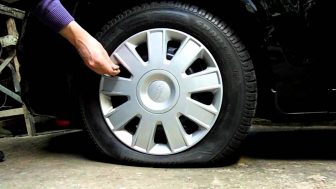
If you are a driver, you should ideally know how to pump air or pressure into your vehicle tyres.
Car tyres sometimes get deflated when they sustain punctures.
In Bahasa Malaysia, which is our National Language, the word pancat or ‘puncture’ is to experience a tyre that has lost its air.
Pertaining to tyres, bocor or ‘void of air’ or in other word having ‘no air’ or ‘pressure’ in one’s tyres, is in fact not a simple matter.
It can cause quite a headache to some drivers, especially the female ones.
Before I continue with today’s article, you might wish to know, what is ‘air’ or ‘pressure’ in our National Language.
The equivalent for the above two words is simply angin.
But surprisingly, angin can also go on to denote or classify someone who is an ‘eccentric’ or of unstable behaviour.
Therefore if people brand you as kepala angin, that means that you are in reality, someone who has a screw loose in the head.
You should therefore be careful of how you use this word.
Lest we stray too far away from today’s topic in question, readers may be wondering why ‘pressure’ has been selected for our discussion today.
It surprised me tremendously, when one afternoon, my wife came home and retorted to me, “I don’t seem to be able to pump air or insert air pressures into my car spare tyre.”
Impossible, was my reply to her.
Until it dawned upon me that she may very well have a point after all!
You see, drivers may feel that pumping air into one’s vehicle is after all, a rather simple task.
Well, do not be surprised.
Continue reading as you may discover that the above ‘task’ might end up being not that simple as you think after all.
Allow me to explain briefly how a ‘pressure dispersing machine’ found in most petrol stations function or work.
Don’t be surprised there might be some of us drivers or motorcycle riders who after all, might not be too well acquainted with the above equipment.
How Does a Pressure Dispensing Machine Work?
Unlike older versions, air dispensing machines at petrol kiosks these days use the metric system. P.S.I or ‘pounds per square inch’ should be quite familiar with most people.
In this article, it is also assumed drivers already know what level of tyre pressures are required for their car tyres.
Front car tyres normally have higher air pressures than back tyres.
After all, it should be realised that as car engines are mostly located in front of the vehicle, thus requiring them to have to be inflated with higher pressures.
As an example, my small Kancil car, its front tyres are usually pumped with approximately 22-26 p.s.i. of air pressures.
The back tyres, however need a lower amount of air pressure, approximately 22-24 p.s.i.
Normal Insertion of Air Pressures
Most people are quite aware or know how to deal with the problem if tyres which are under-inflated.
In such cases, all a person needs to do is to set the air pressure dispensing machine, its dials at say 230 or 32 p.s.i.
Connect the air pressure dispensing hose equipment to your car tyre valve.
Should your car tyre in reality lack the pressure it requires, you will hear a ting-ting or hissing sound as pressures are being inserted.
When sufficient air pressure has been dispensed, the above sounds terminate, indicating completion of the air filling exercise.
What happens when no tinkling or hissing sounds are emitted when you connect your tyre to the air dispensing equipment?
Well, this simply means your tyre does not need the required air pressure that you suspect your tyres require.
In short, you tyre air pressure is then normal.
Get what I intend to say, hopefully.
How does one deal with the problem of tyres which have lost an extensive amount of air pressures is attempted to be inflated?
What happens then?
In such a scenario, a driver will obviously be faced with an unusual problem.
The normal usual settings of the dials of the air dispensing gadget will then not seem to function at all.
In such instances, air pressure or air fails to be emitted.
The machine or air dispensing instrument will not emit a tinkling or hissing sound which it normally emits.
This can either depict machine malfunction or that something is wrong with it.
What then does a driver do?
In actual fact, there is nothing wrong with it.
Do not despair!
What happens is you have failed to set the machine dials correctly.
I will provide you the proper advice to help you solve your predicament.
What then should a person do?
Well, you should in reality set the machines to the correct dials to enable it to function properly.
You are further advised to go to column 3 of the air pressure dispensing machine.
Basically it looks like the diagram given below.
Press the ‘Total Tyre Puncture’ button.
Spurts of air pressure will be dispensed.
This will assist the punctured tyre to be inflated.
Air pressures will be dispensed for a 1-2 minute duration.
If these spurts of air fail to inflate up your tyre, press the button again.
Do this over again until the tyre is fully inflated.
Now that I have guided you through the process of inflating your punctured tyre, you should now feel capable of overcoming your emergency.

Leave A Comment